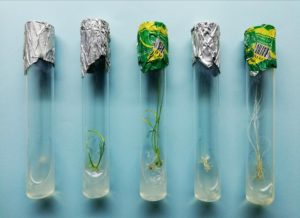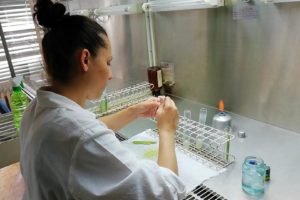LABORATORY OF BIOTECHNOLOGY
The main activity of this laboratory is development of double haploid lines to shorten the breeding process of common wheat, triticale and durum wheat.
The selection of genetically uniform lines in the course of the breeding process is a labor-consuming activity, which requires a long period of time. The haploidy method allows for the fast maintenance of heritability and production of stable lines within a single generation. The cultivation of anthers under in vitro conditions (anther culture) is an easy and efficient method for generating haploid regenerant plants, which, after doubling of the chromosome number, become completely uniform dihaploid lines. Thus, the time needed for the development of genetically stable lines is reduced considerably.
In the Laboratory of biochemistry, the anther culture method has been applied since 1986/7 to common wheat, and since 1994/5 – to triticale. Annually, out of tens of crosses, several thousand anthers are introduced in culture and thousands of haploid plants are regenerated from them. On the following year, the ready dihaploid lines are tested and evaluated under field conditions, while in the progenies of the same crosses the selection for stabilization goes on for another two or three years. Over time, numerous promising lines were obtained, four dihaploid common winter wheat cultivars were released, as well a one triticale cultivar, and work has been done with Bulgarian and foreign companies for commercial production of double haploid lines.



Another method used at the laboratory is embryo rescue – growing under in vitro conditions of immature embryos from crosses of distant species to obtain hybrid plants. This approach further widens the possibilities for synthesis of new species and transfer of valuable traits into cultural plants. Work has been carried out on immature embryos from crosses with wild species, and recently – for production of initial forms of triticale.
The two bio technology methods are of double significance for breeding – fast stabilizing of segregating progenies based on anther cultivation and developing of new genetic variability from distant hybridization through embryo rescue.
In sunflower, the method of embryo cultivation under in vitro conditions is used for acceleration of the breeding process. By producing annually 3-4 generations, fertility restorer lines, B lines and their sterile analogs are developed and maintained.
Through embryo rescue cultivation, the uncrossability of embryos from materials with interspecific and intergeneric origin is overcome.
Clonal micro propagation is used to maintain and restore accessions from wild annual and perennial species, which are difficult to multiply under unfavorable conditions.



LABORATORY OF BIOCHEMISTRY
The directions of research work are determining the content and allelic composition of the storage endosperm proteins of different cereal crops.
In sunflower and the leguminous crops, analyses are carried out on the following more important parameters, which concern important areas of breeding researches:
- Determining oil percent (%) in the whole seed, in the kernel and in the husk;
- Determining protein content (%) in the whole seed, in the defatted kernel and in the seed meal;
- Cooking time of legumes and rice (min);
- Protein content in the seeds of leguminous crops (%);
- Amount of seed coat of legumes (%);
- Taste (rank).

LABORATORIES OF PLANT PATHOLOGY OF CEREALS AND LEGUMES
The researches here are related to determining of the virulent and aggressive variability in the populations of phytopathogens of key importance for Bulgaria, as well as evaluation of the resistance of the initial and breeding material under field and controlled conditions.
The phytopathological researches at Dobrudzha Agricultural Institute started in 1960. A special program was developed to target the problem with diseases on wheat. A major direction of research work were immunological studies to develop and introduce in production cultivars with resistance to the economically important diseases on wheat: brown, stem and yellow rust and powdery mildew.
The phytopathological investigation on brown rust started in 1960 with the major goal to study the race composition and find sources of resistance to assist the breeding process towards developing of resistance in the new wheat varieties.
In 1966 began the studies on powdery mildew and black rust, and in 1977 – on the resistance of wheat to yellow rust.
Currently the researches toward developing resistance to powdery mildew and stem rust are focused on the following areas: 
- Determining the virulent variability in the populations of the causative agent of powdery mildew;
- Collection, maintenance and enrichment of the gene pool of lines and varieties resistant to powdery mildew and stem rust; annual investigations on the gene pool under infection field conditions and at second leaf stage of the wheat plants for resistance to races of different virulence under greenhouse conditions;
- Analysis and evaluation of new breeding materials against artificial infection background to help the breeding process in the selection of varieties with good resistance to powdery mildew and stem rust;
- Investigating and determining the nature of the resistance of wheat cultivars to powdery mildew;
- Testing of new fungicides as a means of protection of the wheat crops against economically important diseases.
The immunological studies are carried out under field conditions in an artificial infection field and under laboratory conditions with controlled climatic parameters.
The virulence variability in the powdery mildew populations is investigated under field conditions at parameters optimal for the development of the pathogen: temperature, light and relative air humidity.
LABORATORY OF PLANT PATHOLOGY OF SUNFLOWER
In the Laboratory of sunflower phytopathology, the resistance of the breeding materials and the new released lines and hybrids to the following economically important diseases and parasites is being determined:
- Downy mildew (Plasmopara halstedii Berlese et de Toni);
- Phomopsis (Phomopsis helianthi-Cvet. et al.);
- Phoma (Phoma macdonaldii);
- Alternaria (Alternaria sp.);
- Sclerotinia (Sclerotinia sclerotiorum);
- Broomrape (Orobanche cumana).
The breeding materials from distant hybridization and wild species from genus Helianthus are tested in an artificial infection field in Dobrudzha Agricultural Institute.
The changes in the physiological specialization of the pathogens and the parasite Orobanche are annually followed at the laboratory.
GENETIC STOCK CENTER
This is ex-situ storage of the sunflower breeding materials.
The plant genetic resources from sunflower under ex situ storage include the following: wild perennial species from genus Helianthus (244 accessions), and wild annual species of genus Helianthus (184 accessions). Collections of foreign varieties and CMS sources are also stored for the purposes of research work.
LABORATORY OF PLANT PHYSIOLOGY
The main activity of this laboratory, which was established as early as 1963, is evaluation of the breeding materials from the species wheat, triticale and barley according to their cold and drought resistance.
 To improve cold resistance, researches are carried out on the processes of hardening and de-hardening of the winter cereals. Studies are being done on the inheritance of cold resistance. Foreign and own materials are evaluated as initial parental components, and new breeding lines are investigated.
To improve cold resistance, researches are carried out on the processes of hardening and de-hardening of the winter cereals. Studies are being done on the inheritance of cold resistance. Foreign and own materials are evaluated as initial parental components, and new breeding lines are investigated.
For improvement of drought resistance, evaluation is done of the new lines, as well as assessment and characterization of the new varieties. Physiological parameters related to drought resistance and productivity are being investigated.
The accumulated data are a prerequisite for the development of cereal cultivars with cold and drought resistance suitable for the different soil and climatic conditions of Bulgaria.
LABORATORY OF GRAIN AND BREAD PECHNOLOGICAL PROPERTIES
The research work is related to analysis of the breeding materials from common wheat and triticale with regard to their bread making properties and parameters.

LABORATORY OF AGRO CHEMISTRY
Agrochemistry is the science of interaction between plants, soil and fertilizers in the process of growing agricultural crops, of the circulation of substances in soil and the appropriate use of fertilizers in the process of production.
The main task of agrochemistry is to study and manage the balance between the chemical elements in the soil-plant system, taking into consideration the specificity of the location of growing and the crop. It studies also the changes in the plants, soil, pesticides and fertilizers during their interaction.
The contemporary agrochemical science is focused on the ways to influence the physical-chemical and biological processes in the soil that can be a prerequisite for increasing the quantity and quality of the plant breeding production.
The following parameters are determined at the Laboratory of agrochemistry:
- Soil acidity;
- Content of total carbon and humus in soil;
- Fraction composition of the active matter in soil;
- Total nitrogen and phosphorus content in soil;
- Mineral nitrogen forms in soil;
- Percent of nitrogen, phosphorus and potassium in the plant material;
The acetate lactate method, which was developed at this laboratory, is now in use in the agro-chemical researches in Bulgaria to determine the need of phosphorus and potassium fertilization.
LABORATORY OF PHYSICAL PROPERTIES OF SOIL
The physical and water properties of the soil determine its air, water and temperature regime. These characteristics differ in the individual soil types, they are not constant and change under the effects of the natural conditions and the used agronomy practices. The knowledge on these properties and their proper interpretation and values help for the timely application of suitable practices (soil tillage, fertilization with organic fertilizers, green fertilization, ameliorations, etc.) to improve the physical and water characteristics of the soil thus ensuring good conditions for growth and development of the plants and stable and quality yields from them.
The following main physical and water characteristics of soil can be determined in the laboratory of physical properties of soil: structure, water resistance of the soil structure, bulk density, total porosity, maximal capillary water absorption, capillary increase of water, soil moisture.

Soil units

Water resistance

Density
